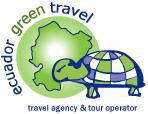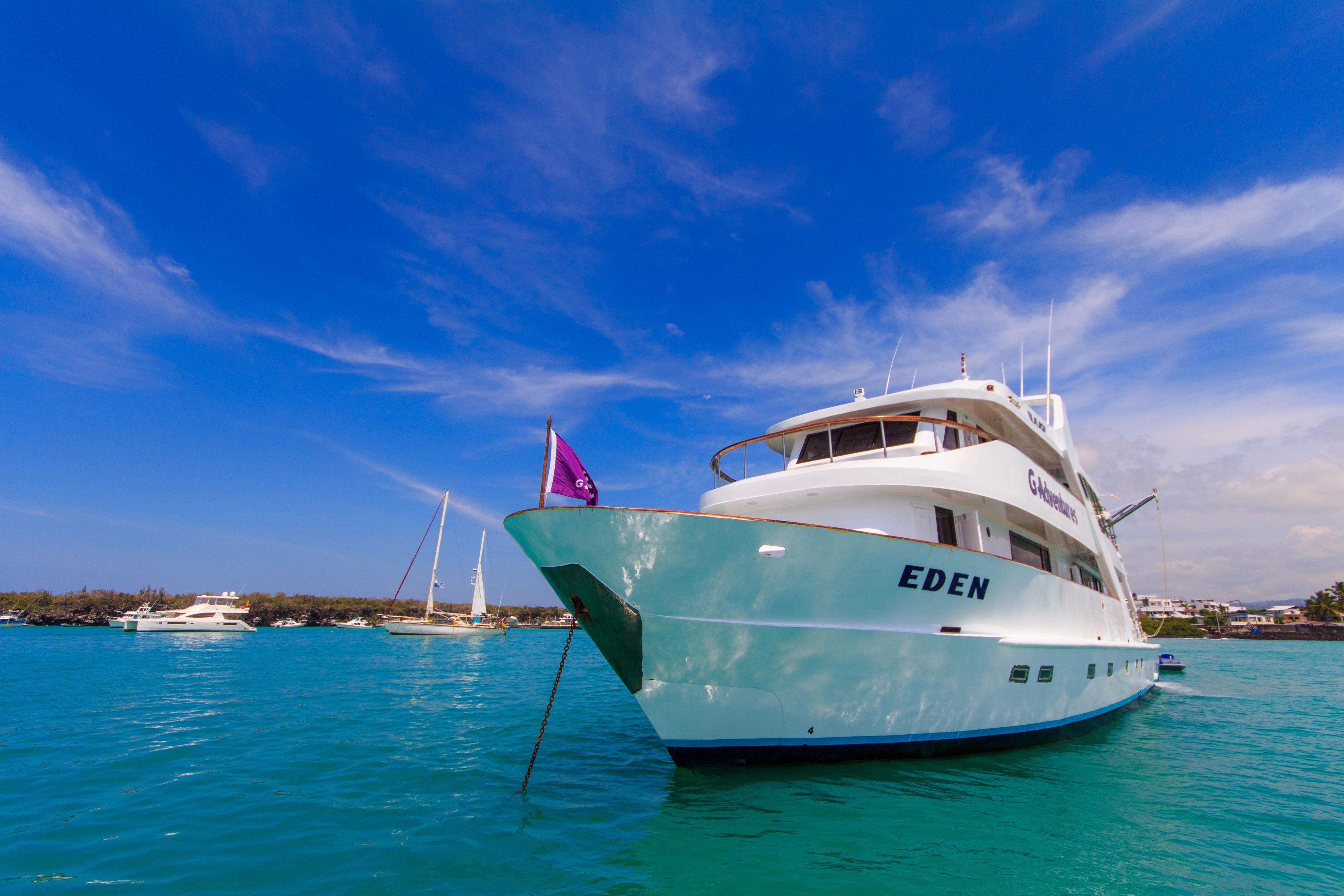DAY 1: SUNDAY
FLY TO GALAPAGOS – NORTH SEYMOUR
Early in the morning you will catch your flight from mainland Ecuador to the Galapagos. Arriving to the airport, you must first pay the National Park entrance fee of U.S. $100 per person before collecting your luggage. Leaving the arrival hall, the National Park Guide of the “Angelito I” will be waiting for you and accompany the whole group to the Baltra harbor, where the “Angelito I” is anchored. Now the cruise can begin! You begin your Galapagos adventure with a wildlife-filled visit to North Seymour, an Island very close to Baltra and Santa Cruz Islands. On your walk with the naturalist guide, you will observe abundant and entertaining birdlife as well as a sizeable sea lion colony. On North Seymour, blue-footed boobies make their nests on the ground right below nesting Magnificent Frigate birds. You will likely see the male frigate birds inflate their incredible neck pouches, hoping to attract some lucky females flying overhead. The trail ends at a scenic beach where loads of sea lions love to sunbathe. Along this visit, you’re also likely to see Sally Light-foot crabs, marine iguanas, and swallow-tailed gulls. (Lunch, Dinner)

DAY 2 : MONDAY
CHINESE HAT – BARTOLOME
Sombrero Chino is a small islet located near the south-east coast of Santiago. It is an island consisting of a cone type “Splatter” (lava ejected as drops and falls close to where it came from, which forms a cone inclined) that forms the summit and many lava tubes that go down to the coast. On the west you can see pillow-type lava formations, which are an indicator that the flows were formed under the sea and have been raised upward, which is why coral heads are found on the lava. With your guide, you will walk along the gorgeous white sand beach and learn about these lava formations. You will also have the chance to go snorkeling where it’s likely to swim with Galapagos penguins, sea lions, and white-tipped reef sharks. From a dry landing on a jetty, you take the summit trail that first goes over sand and then leads to the top of Bartholomé on a wooden staircase. The view from the top of Santiago with Sullivan Bay and the surrounding islands is wonderful. All the secondary cones, lava flows and lava tubes mimic a moon landscape. After the hike, you will snorkel around Pinnacle Rock, the famous landmark of Bartolome. With the dinghy you go along the coast of Bartolomé to look for the Galapagos penguins. This is the largest colony of penguins in the Galapagos and you are extremely like to swim with them here and see them nesting. The penguins live and nest in the lava tubes of the rocky coast, along which they also fish. (Breakfast, Lunch, Dinner)

DAY 3 : TUESDAY
GENOVESA: DARWIN BAY – PRINCE PHILLIPS STEPS
Genovesa Island is known for its outstanding birdlife, even if you’re not a bird enthusiast, you will likely be delighted by the large colonies of red-footed boobies, masked boobies, frigate birds, and storm petrels. Also, since the Island is only visited by cruises, it’s usually fairly uncrowded. Darwin Bay was created by the collapse of a huge, underwater crater — this also explains the horseshoe shape of Genovesa Island. You first land on a white coral beach where you will immediately spot several birds on land and soaring overhead. Great frigate birds display their inflated, bright red neck pouches to attract passing females; Nazca and blue-footed boobies tend to their nests on the ground below; and mockingbirds sprint across the sand. Nearby tidal pools in the volcanic rock are places for wandering tattlers, lava gulls, whimbrels and turnstones to hunt for seafood. On this walk, you’re also likely to see the sharp-beaked finch, large cactus finches, large ground finches, Galapagos doves and swallow-tailed gulls. At the end the trail you reach a cliff’s edge where you can enjoy an amazing view of the Island and ocean beyond. After this walk, you can enjoy swimming or snorkeling in the natural harbor. In the afternoon, you visit Prince Philip’s Steps, the only other visitor site on Genovesa. The visit begins with a view of the rocky shore where many birds nest and raise their young. On the trail here one may observe red-billed tropicbirds, nesting boobies and a colony of storm petrels. Genovesa Island offers a chance to also spot the Galapagos short-eared owl and the Galapagos fur seal as well as several species of finches, herons, and petrels (Breakfast, Lunch, Dinner)

DAY 4 : WEDNESDAY
PUERTO EGAS – RABIDA
Today begins with a hike and snorkeling at Puerto Egas, aka James Bay. This spot is home to the fascinating Galapagos hawk as well as Galapagos oyster catchers and Galapagos lava lizards. We will walk to the coastline where we observe tidal pools and an abundance of Galapagos sea lions. Here the Galapagos Fur Sea Lions bathe in the sun. While snorkeling, you swim alongside reef sharks, turtles, and rays. Later in the day, you will visit La Rabida, another small but fascinating Island. The first thing you’ll notice on La Rabida are its unique red cliffs and beaches. While walking on this Island, you’re likely to spot sea lions, pelicans, Galapagos hawks, Darwin finches, marine iguanas, flamingos and blue-footed boobies. You will also have time to go for a snorkel in the waters just off La Rabida, where you will hopefully swim with sea lions and tropical fish. (Breakfast, Lunch, Dinner)

DAY 5 :THURSDAY
DARWIN STATION – HIGHLANDS OF SANTA CRUZ
The Charles Darwin research station is located in the town of Puerto Ayora on Santa Cruz Island and it’s a 10-minute walk from the center of town. At the Charles Darwin Research Station you’ll learn first-hand of the conservation and research efforts in the Galapagos islands. See the tortoise hatchlings and breeding programs which are saving several races of tortoises from extinction. You’ll also see several species of giant iguanas that are being saved from extinction as well. The Charles Darwin Research Station conducts and facilitates research in the Islands and you’ll learn about their important research here at the station. [Travelers joining the 4-day cruise arrive in the Galapagos this morning and are transferred from the airport to meet up with the group in the Santa Cruz highlands]. [Travelers doing the 5-day cruise are transferred to the Baltra airport after this visit. In Baltra, they will board the flight headed back to mainland Ecuador]. Highland Santa Cruz: Drive up to the highlands in a bus. In a short time one can see the transition between the different vegetation zones from the Arid zone to the Transition zone up to the Scalesia zone (and agricultural area). The highlands offer the lush humid zone with its vegetation of Miconia bushes, Scalesia and inactive volcanic cones. You will walk to Los Gemelos (meaning “twins”) which are two big pit craters in the middle of a wonderful Scalesia forest. These endemic trees and the lush vegetation, with a lot of different ferns, mosses and liverworts, show a totally side of the Galapagos. Darwin’s Finches and the vermilion flycatcher inhabit this area. (Breakfast, Lunch, Dinner)

DAY 6 : FRIDAY
ESPAÑOLA: PUERTA SUAREZ – PLAYA GARDNER
Española Island (or Hood Island) is a true highlight in the Galapagos, both above and below the water. Due to its very remote location, there are a large number of endemic species that evolved independently from the rest of the archipelago. Gardner Bay is a spectacular, long, white-sand beach where one can swim with sea lions and wander at your own pace. Your guide will lead you while snorkeling, pointing out wildlife like green sea turtles, manta rays, white-tipped reef sharks, and tropical fish. Afterwards, you will visit Punta Suarez. This site offers quite a display of wildlife: marine iguanes with copper red patches, swallow-tailed gulls, the endemic long-billed mocking bird, finches, mockingbirds, masked and blue-footed boobies, oystercatchers, sea lions, and lava lizards. This is the only island where the waved albatross is to be seen during their breeding season. From April through December, the fascinating waved albatrosses are found on the Island performing mating rituals, nesting, and raising their young. (Breakfast, Lunch, Dinner)

DAY 7: SATURDAY
SANTA FE – SOUTH PLAZA
Santa Fe Island has one of the most beautiful coves of all the visitor sites in the region, a turquoise lagoon protected by a peninsula of rocks and small islands that extends from the shore. The Santa Fe species of iguana are a brighter yellow color and have uncommonly large spikes on their spine. The opuntia cactus, a favorite food of the land iguana, grows unusually tall here, up to 33 feet high and are the largest of their kind in Galapagos. Manta rays and sea turtles may be seen against the sandy bottom of Santa Fe’s beautiful anchorage. Today you will have a few opportunities to snorkel, hopefully swimming with sea lions and colorful fish. South Plaza Island has one of the largest populations of land iguanas in the archipelago and can be observed feeding on the prickly pear cactus. There are also iguanas that are a cross between the marine and land varieties. Along the sea cliffs frigate birds, shearwaters, brown pelicans and masked boobies may be seen. You may snorkel from the beach where turtles, sharks and other fish are found. One of Plazas attractions is also a colony of bachelor sea lions who laze around on the sand. Depending on the season, the sesuvium ground vegetation changes its color from intense green in the rainy season to orange and purple in the dry season. (Breakfast, Lunch, Dinner)

DAY 8: SUNDAY
BLACK TURTLE COVE – DEPART GALAPAGOS
With the dinghy we go into Black Turtle Cove, a big protected mangrove cove located in a remote corner of Santa Cruz Island. In the far away small corners the motor of the dinghy is turned off so we can travel noiselessly and observe the marine turtles. There are a lot of them in the cove during mating and nesting season (December to February), but even out of season there are always some turtles staying back in the mangrove cove to rest. Spotted eagle rays, golden rays, white-tipped reef sharks and young Galapagos sharks can often be spotted. At the end of the cruise, the passengers leave the Angelito again at the Baltra harbor. Your guide takes care of everything until you’re on your flight back to the continent. (Breakfast)


























